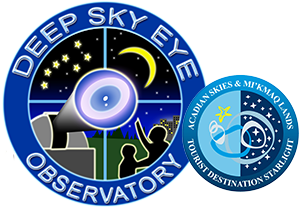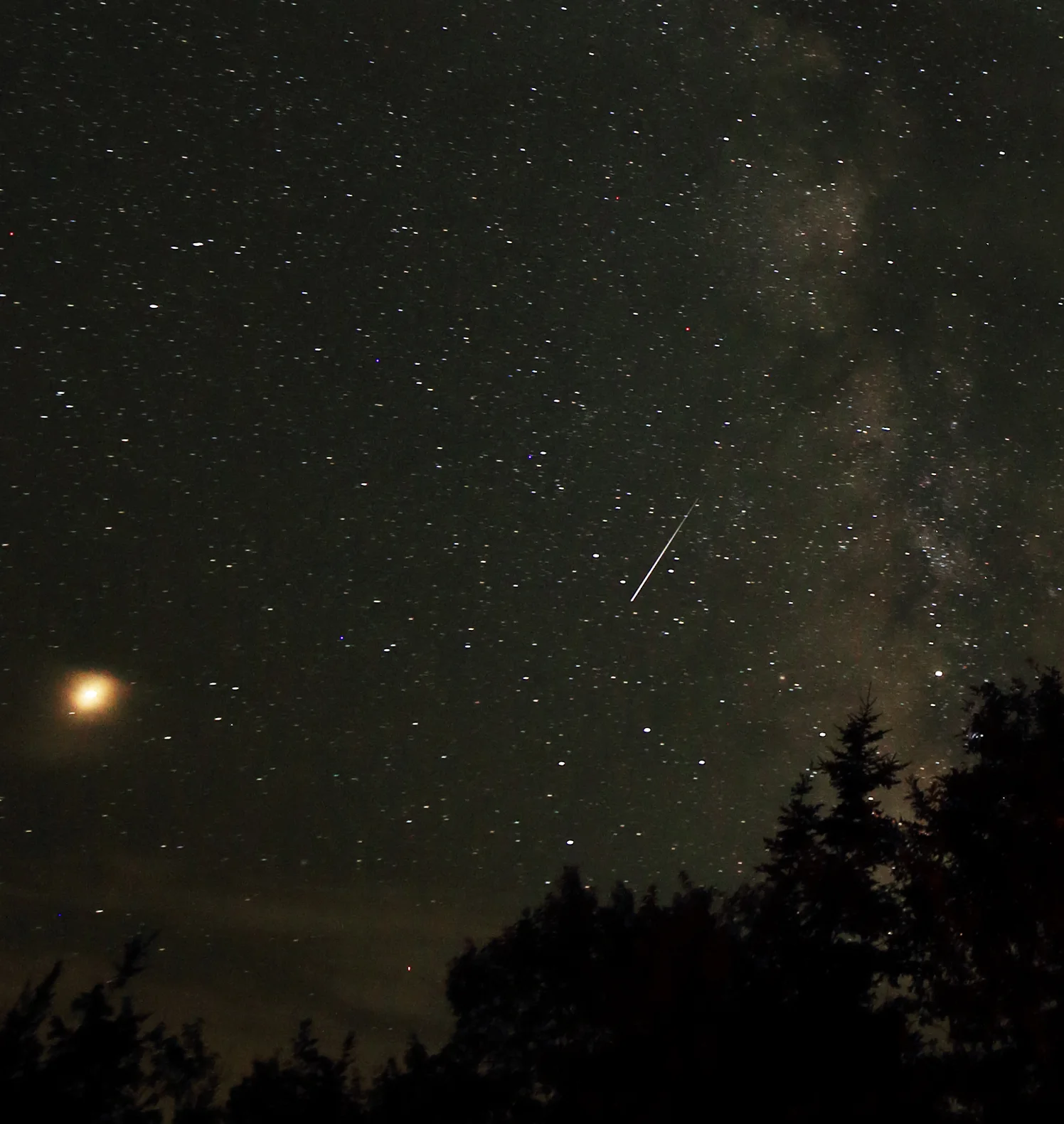Streaks and Trails across the Sky
Tim presents his video lecture session "al fresca" on a mild night.
The past week or so has seen a battle between fog and meteors. Some nights were simply too hazy for good viewing, while others featured brilliant and very active skies. On Sunday, August 5, we were treated to an early display of meteors from the Perseids and an ongoing show by the Aquariids, in totally different directions. They were zipping overhead like crazy! The visitors sat in the sky circle and stared up in awe. Tim's usual sky tour was punctuated by exclamations and gasps as each new meteor streaked overhead.
On Friday night, after an unsettled week of rather poor visibility, conditions repeated those of the previous Sunday. Because the size of the group was 22 people, Tim set up his video screen on the outside of the observatory and everyone gathered in a semicircle to watch and listen. As darkness intensified, the Milky Way rose and the meteors began to arrive. We were closer to the Perseids peak, so this was anticipated, although there are no guarantees. While predawn viewing is normally best for many of these events, we found that after 10 PM was a very productive time for action above us. Several of these meteors left long, smoking trails. I gave the guided sky tour to half of this group, while the other half went up to the dome, and then they switched places. Once more, the tour was interrupted by exclamations as each new meteor shot across the heavens. I missed some that the audience could see behind me. But that was okay; they were experiencing a rare treat and many had never seen such clear skies for meteor-watching. None of us expected this number to appear!
Fast-forward to Sunday, August 12. This was the Perseid shower's peak night and it did not disappoint. A smaller group enjoyed the performance, which was at its best around 10:30 or so – before some mistiness drifted in. As midnight approached, much of the clarity was gone, but by then everyone was in the dome and the telescope could find plenty to see.
These meteor showers often seem to coincide with bright moonlight, so it was a pleasure to have no moon interference with these. I remember last year's Perseid peak: it rained. Might have been a decent affair but we missed it. Not so this time!
Displays of this nature serve as reminders of just how much is "up there", and where it comes from. The meteors are remnants and particles from various bodies, normally comet fragments in an elliptical orbit through which the earth passes each year. The Perseids are shed from comet Swift-Tuttle. The Aquariids – and there are two groups of these, one north and one south – come from breakups of Marsden and Kracht sungrazing comets, which are quite young and closely approach the sun. Each fragment is tiny, often the size of pea gravel. Its vivid flare comes from friction as it enters the atmosphere. Larger pieces can fall to the surface and sometimes cause damage, although this is uncommon. A few explode as they fall, and these are called bolides or fireballs. They're pretty impressive! After I returned home and continued skywatching, I spotted one such bolide as it burst into light above my trees. I was able to catch a part of it with my camera – sheer luck. Astrophotographers set long exposures in the direction of the radiant point, from which each meteor shower originates, and hope for the best. We take our shots over, and over, and over. Many do time-lapse exposures that continue all night, automatically. Tim set up a couple of these during two different nights. I had to be content with manually doing 30-second images.
In the end, our response to this month's Meteor Week was very positive. Many years tend to be less than stellar (no pun) where meteors are concerned. Anxiously, people watch and wait, and wait, and wait - only to see a couple brief fizzles and a lot of empty sky. But not so in 2018!
There are other meteor showers to come. The Old Farmer's Almanac always includes a Canadian list of these, as do astronomy websites such as EarthSky. Our next ones will be the Draconids in October around the 7th through 9th, and again, there won't be moonlight to interfere. So if you missed the Perseids, mark your October calendars for the next show. It's free and it's often unforgettable.
Below - a selection of meteor shots!
Bolide falling behind trees at my home near Tusket, a 20-minute drive from Deep Sky Eye
The International Space Station (ISS) passing over the dome at center top, with a Delta Aquariid meteor at right, and Mars at left. Taken August 5, 2018
Delta Aquariid meteor taken at Deep Sky Eye site, with Mars at left




